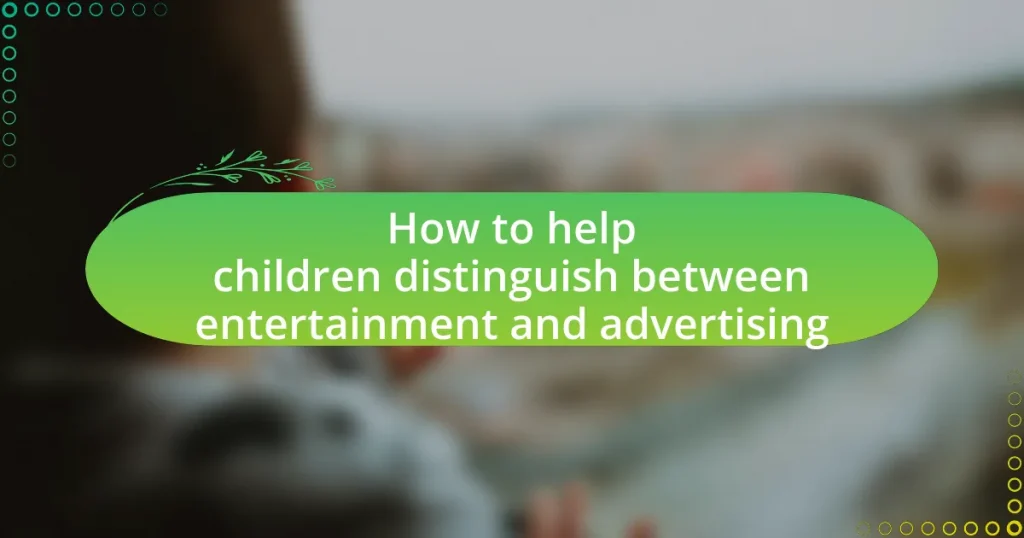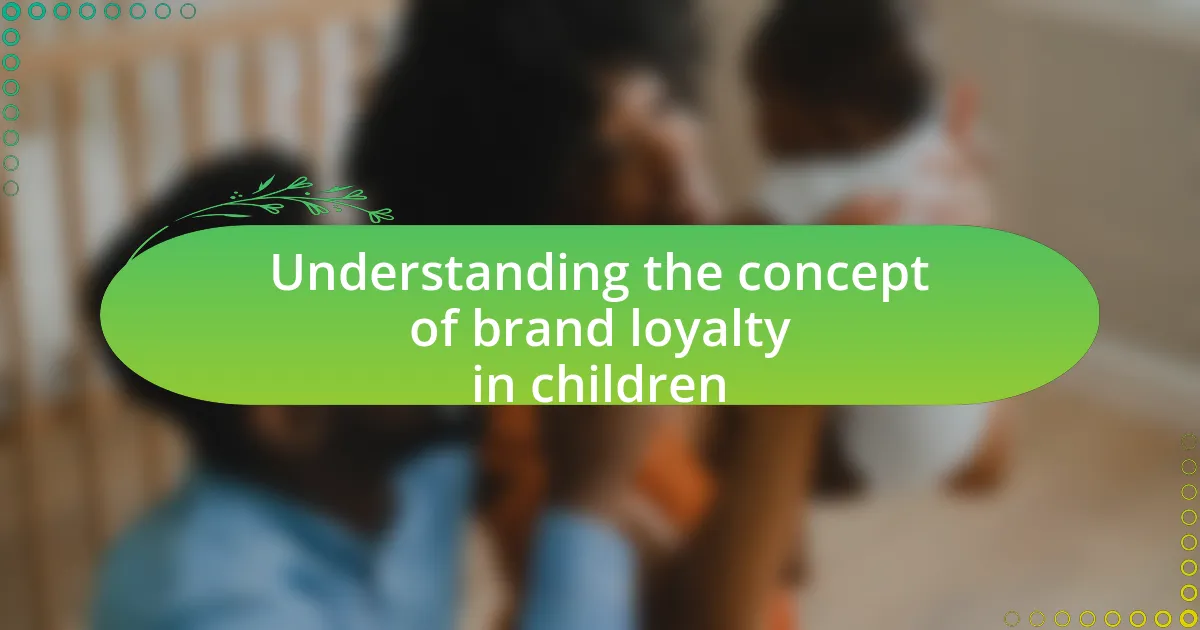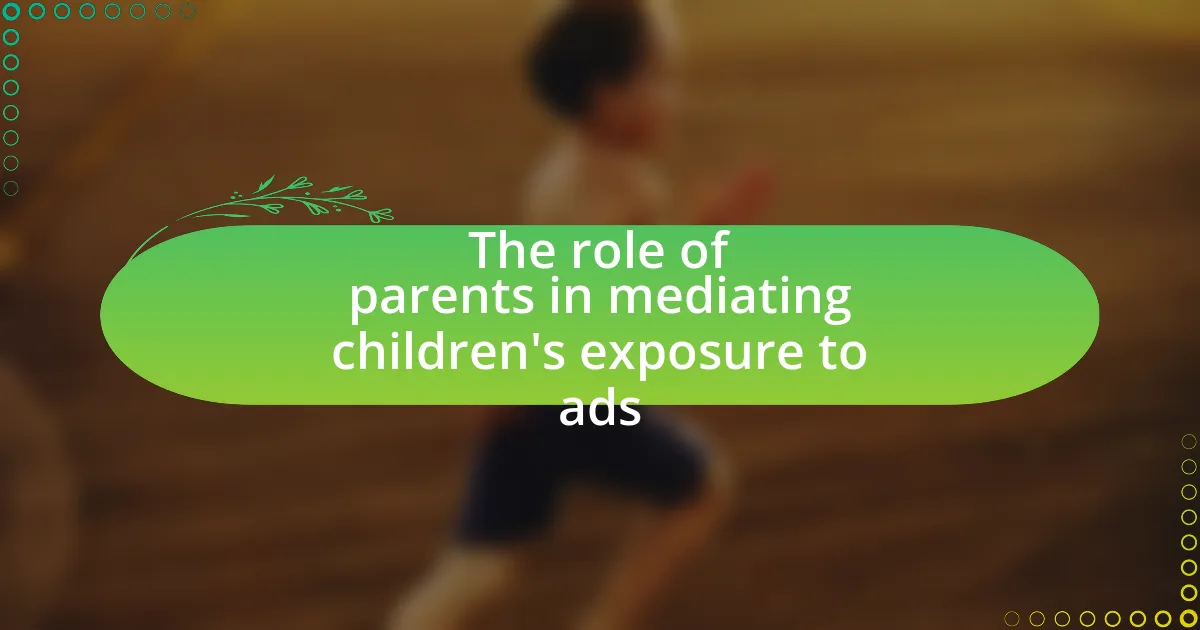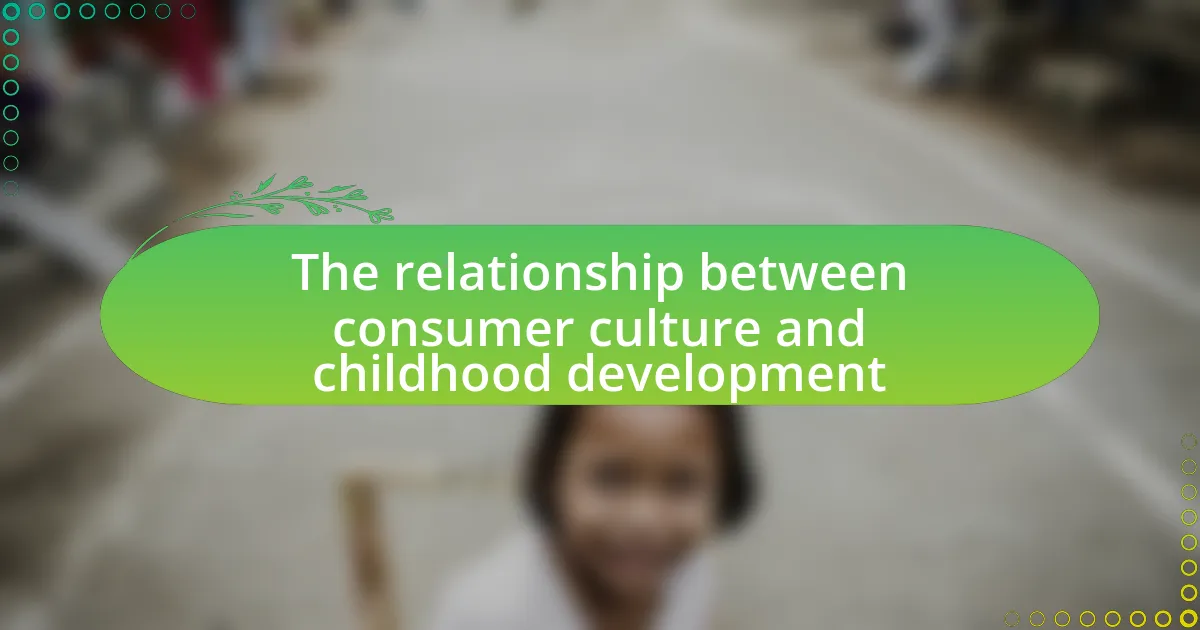The article focuses on helping children distinguish between entertainment and advertising, emphasizing the importance of this skill for developing critical thinking and informed decision-making. It outlines the cognitive challenges younger children face in recognizing the persuasive intent behind advertisements and highlights the role of age in understanding these concepts. The article also discusses strategies for parents to facilitate this learning, including engaging discussions, media literacy education, and practical activities that reinforce the differences between entertainment content and advertising. Additionally, it addresses common misconceptions and resistance children may have, providing best practices for fostering media literacy at home.
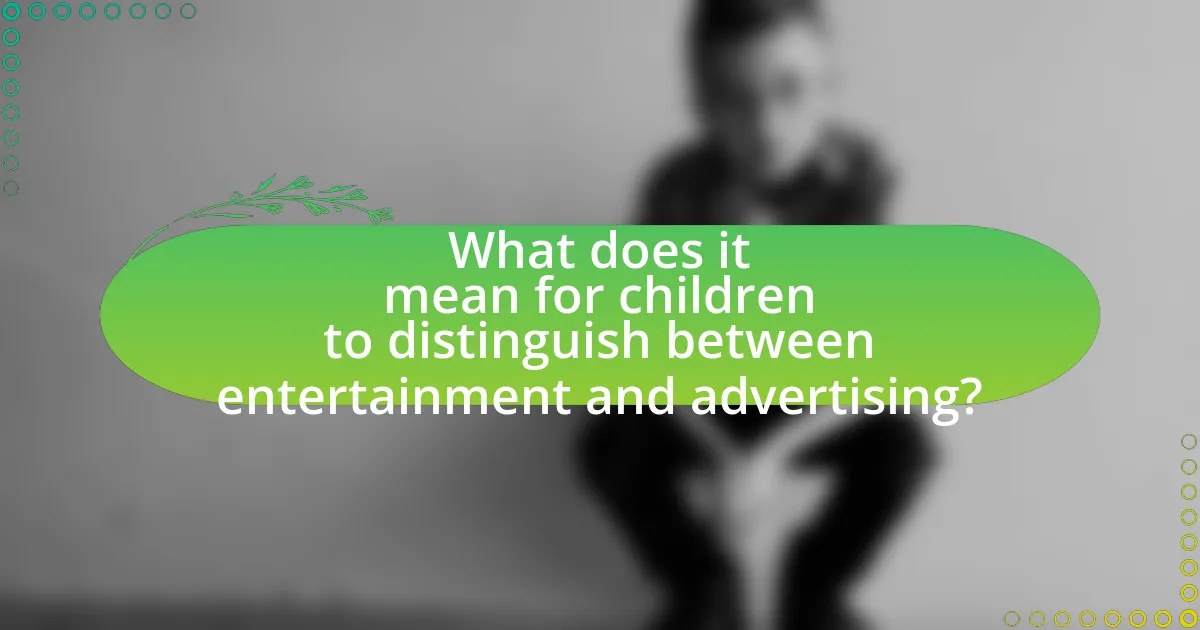
What does it mean for children to distinguish between entertainment and advertising?
For children to distinguish between entertainment and advertising means they can recognize the difference between content designed to entertain and content intended to promote a product or service. This ability is crucial as it helps children develop critical thinking skills, enabling them to understand the persuasive intent behind advertisements. Research indicates that children under the age of eight often struggle to differentiate between the two, which can lead to increased susceptibility to marketing tactics. By age 12, many children begin to grasp these distinctions, allowing them to make more informed choices regarding media consumption and consumer behavior.
Why is it important for children to understand the difference?
It is important for children to understand the difference between entertainment and advertising because this knowledge helps them develop critical thinking skills and make informed choices. Recognizing the distinction allows children to discern persuasive messages and understand the intent behind advertisements, which often aim to influence their behavior and purchasing decisions. Research indicates that children who can differentiate between these two forms of media are less susceptible to manipulation and more capable of evaluating the credibility of information presented to them. For instance, a study published in the Journal of Consumer Research found that children who received media literacy education demonstrated improved ability to identify advertising tactics, leading to healthier consumption habits.
What are the potential consequences of not distinguishing between the two?
Not distinguishing between entertainment and advertising can lead to children developing misconceptions about the nature of media content. This confusion may result in children being more susceptible to manipulative marketing tactics, as they may not recognize advertisements as persuasive messages designed to influence their purchasing decisions. Research indicates that children under the age of eight often lack the cognitive ability to understand the intent behind advertising, which can lead to increased materialism and unrealistic expectations about products. Furthermore, failing to make this distinction can hinder critical thinking skills, as children may not learn to analyze and question the motives behind various media messages.
How does this understanding impact children’s decision-making?
Understanding the distinction between entertainment and advertising significantly impacts children’s decision-making by enhancing their critical thinking skills. When children learn to differentiate between these two forms of media, they become more discerning consumers, capable of evaluating the intent behind messages. Research indicates that children who are educated about advertising techniques are less likely to be influenced by misleading advertisements, as they can recognize persuasive strategies. For instance, a study published in the Journal of Consumer Research found that children who received media literacy training demonstrated improved ability to identify advertising tactics, leading to more informed choices regarding products. This understanding fosters autonomy in decision-making, allowing children to make choices based on informed judgments rather than impulsive reactions to advertisements.
What are the key characteristics of entertainment and advertising?
The key characteristics of entertainment include engagement, enjoyment, and emotional connection, while advertising focuses on persuasion, promotion, and information dissemination. Entertainment aims to captivate audiences through storytelling, humor, or visual appeal, often creating a memorable experience that resonates emotionally. In contrast, advertising seeks to influence consumer behavior by highlighting product benefits, creating brand awareness, and prompting action, often using persuasive techniques such as testimonials or catchy slogans. These distinctions are crucial for children to understand, as they help differentiate between content meant for enjoyment and content designed to sell products.
How can children identify the features of entertainment?
Children can identify the features of entertainment by recognizing elements such as storytelling, humor, engaging visuals, and relatable characters. These features are often present in movies, television shows, and games designed for children, which aim to captivate their attention and evoke emotions. Research indicates that children as young as three can differentiate between entertainment and advertising by understanding narrative structures and character development, as shown in studies like “Children’s Understanding of Advertising: The Role of Age and Experience” by John P. Murray and colleagues. This understanding helps children discern the purpose of content, allowing them to distinguish between entertainment and promotional material.
What elements are commonly found in advertising?
Common elements found in advertising include visuals, slogans, calls to action, and brand logos. Visuals, such as images or videos, capture attention and convey messages quickly. Slogans are memorable phrases that encapsulate the brand’s identity or value proposition. Calls to action prompt the audience to take specific steps, such as visiting a website or making a purchase. Brand logos serve as recognizable symbols that help consumers identify and differentiate products. These elements are strategically used to influence consumer behavior and create brand awareness.
How do children perceive entertainment and advertising differently?
Children perceive entertainment as enjoyable content designed for leisure, while they view advertising as persuasive messages aimed at influencing their purchasing decisions. Research indicates that children often struggle to differentiate between the two, as they may not recognize the intent behind advertisements. A study published in the Journal of Consumer Research by authors Anna S. McAlister and John G. Lynch found that children under the age of eight are particularly susceptible to this confusion, as they tend to interpret ads as part of the entertainment experience rather than as marketing tools. This lack of discernment can lead to an increased likelihood of children being influenced by advertisements, as they may not critically evaluate the content or its purpose.
What cognitive abilities influence their perception?
Cognitive abilities that influence children’s perception include attention, memory, and critical thinking. Attention affects how children focus on and process information, which is crucial when distinguishing between entertainment and advertising. Memory plays a role in how children recall past experiences with media, influencing their understanding of content. Critical thinking enables children to analyze and evaluate the intent behind advertisements versus entertainment, allowing them to make informed judgments. Research indicates that children with stronger critical thinking skills are better at recognizing persuasive intent in advertising (Luna, 2018, Journal of Consumer Research).
How does age affect their understanding of these concepts?
Age significantly affects children’s understanding of the distinction between entertainment and advertising. Younger children, typically under the age of 7, often struggle to differentiate between the two due to their cognitive development stage, which is characterized by egocentrism and a limited ability to understand persuasive intent. Research indicates that children in this age group may perceive advertisements as part of the entertainment content, leading to confusion about the purpose of the messages they encounter (Calvert, 2008, “Children’s Understanding of Advertising: A Review of the Literature,” Journal of Advertising). As children grow older, particularly around ages 8 to 12, they begin to develop critical thinking skills and a better understanding of commercial intent, allowing them to recognize advertising as a separate entity from entertainment. This developmental shift is supported by studies showing that older children can identify persuasive techniques used in advertisements, enhancing their ability to discern between entertainment and advertising (Linn & Novosat, 2008, “The Impact of Advertising on Children: A Review of the Literature,” American Psychological Association).
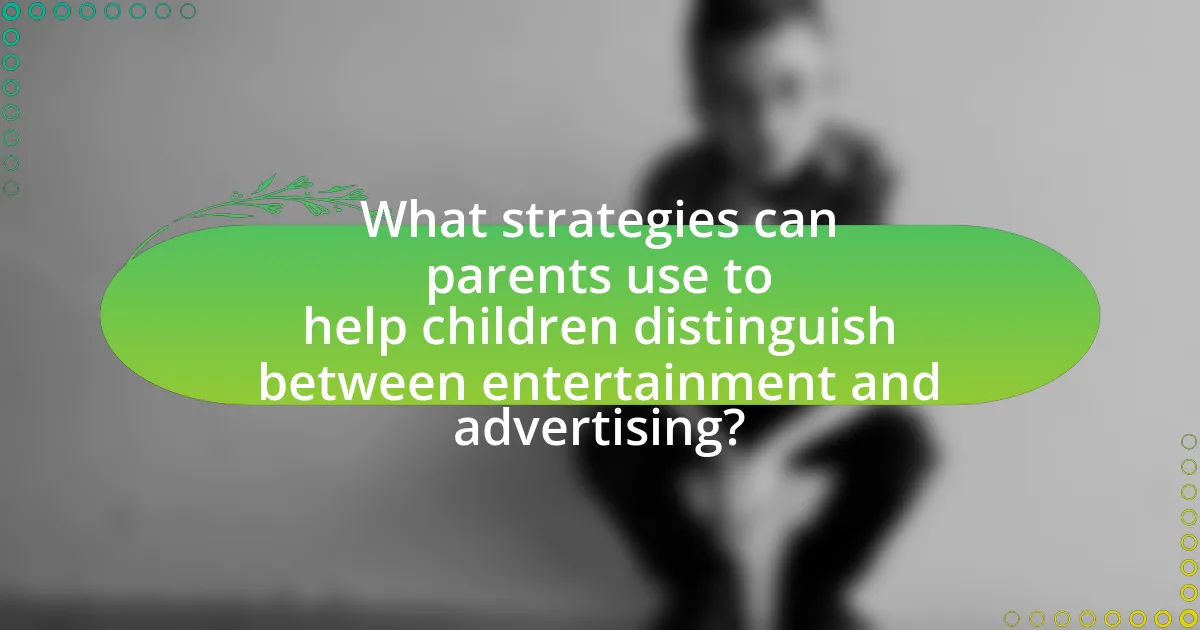
What strategies can parents use to help children distinguish between entertainment and advertising?
Parents can help children distinguish between entertainment and advertising by engaging them in discussions about the content they consume. This strategy involves explaining the purpose of advertisements and how they differ from entertainment, emphasizing that ads are designed to sell products or services. Research indicates that children as young as 3 years old can understand the difference when guided appropriately. For example, parents can watch commercials with their children and ask questions like, “What are they trying to sell?” or “How does this make you feel about the product?” This interactive approach not only fosters critical thinking but also reinforces the understanding that advertisements often use persuasive techniques to influence viewers.
How can discussions about media content aid in understanding?
Discussions about media content can significantly aid in understanding by fostering critical thinking skills and enhancing media literacy. Engaging in conversations about the intentions behind media messages helps individuals, particularly children, recognize the differences between entertainment and advertising. Research indicates that when children participate in discussions about media, they become more adept at identifying persuasive techniques used in advertisements, which can lead to better decision-making regarding media consumption. For instance, a study by the American Psychological Association found that children who were taught to analyze media content showed improved abilities to discern between entertainment and marketing strategies. This understanding is crucial for navigating today’s media landscape, where advertising is often embedded within entertainment.
What questions should parents ask during media consumption?
Parents should ask questions that encourage critical thinking about media content, such as: “What is the main message of this media?” and “Is this content trying to sell something?” These questions help children analyze the intent behind the media they consume. Research indicates that children often struggle to differentiate between entertainment and advertising, making it essential for parents to guide them in recognizing persuasive techniques used in media. For instance, a study by the American Psychological Association found that children under eight years old are particularly vulnerable to advertising messages, highlighting the importance of parental involvement in media consumption.
How can parents encourage critical thinking about advertisements?
Parents can encourage critical thinking about advertisements by engaging their children in discussions about the intent and content of ads. By asking questions such as “What is this ad trying to sell?” or “How does this make you feel?” parents can help children analyze the persuasive techniques used in advertisements. Research indicates that children who participate in discussions about media are better equipped to understand advertising tactics and differentiate between entertainment and marketing messages. For instance, a study published in the Journal of Consumer Research found that children who received media literacy training were more adept at recognizing advertising strategies and less likely to be influenced by them.
What role does education play in this distinction?
Education plays a crucial role in helping children distinguish between entertainment and advertising by providing them with the critical thinking skills necessary to analyze media content. Through structured learning, children can be taught to recognize persuasive techniques used in advertisements, such as emotional appeals and misleading information. Research indicates that media literacy education significantly enhances children’s ability to discern between different types of content, leading to more informed consumption habits. For instance, a study published in the Journal of Advertising Research found that children who received media literacy training were better at identifying advertisements compared to those who did not. This educational approach empowers children to make conscious choices about the media they engage with, fostering a more discerning audience.
How can schools incorporate media literacy into their curriculum?
Schools can incorporate media literacy into their curriculum by integrating lessons that focus on analyzing media messages, understanding advertising techniques, and evaluating sources of information. For instance, educators can design activities where students critically assess advertisements, identifying persuasive strategies and distinguishing them from entertainment content. Research indicates that media literacy education enhances students’ ability to discern between different types of media, fostering critical thinking skills essential for navigating today’s media landscape. A study by the Center for Media Literacy highlights that students who engage in media literacy programs demonstrate improved skills in recognizing bias and understanding the intent behind media messages.
What resources are available for teaching children about advertising?
Resources available for teaching children about advertising include educational websites, books, and interactive programs. Websites like Common Sense Media provide guidelines and lesson plans focused on media literacy, helping children understand advertising techniques. Books such as “The Advertising Effect: How to Change Behavior” by Adam Ferrier offer insights into advertising’s impact, while interactive programs like the Admongo website engage children in learning about advertising through games and activities. These resources collectively enhance children’s ability to distinguish between entertainment and advertising by providing practical knowledge and critical thinking skills.

What are some practical tips for reinforcing this distinction at home?
To reinforce the distinction between entertainment and advertising at home, parents can engage children in discussions about the content they consume. For example, after watching a commercial, parents can ask children questions like, “What do you think this ad is trying to sell?” or “How does this make you feel about the product?” This encourages critical thinking and awareness of persuasive techniques used in advertising. Additionally, parents can create a media literacy activity where children categorize different types of media, such as identifying which segments are ads and which are entertainment. Research shows that children who participate in media literacy programs are better equipped to understand advertising tactics (Levine, 2018, Journal of Media Literacy Education). By actively involving children in these discussions and activities, parents can effectively help them differentiate between entertainment and advertising.
How can parents create a media-savvy environment?
Parents can create a media-savvy environment by actively engaging with their children about media content and teaching critical thinking skills. This involves discussing the purpose of different media, such as distinguishing between entertainment and advertising, and encouraging children to ask questions about what they see and hear. Research indicates that children who are taught to analyze media messages are better equipped to recognize persuasive techniques used in advertising, leading to more informed consumption choices. For example, a study published in the Journal of Advertising Research found that children who received media literacy education were significantly more adept at identifying advertising tactics compared to those who did not receive such training.
What activities can families engage in to practice distinguishing between the two?
Families can engage in activities such as watching television shows or commercials together and discussing the differences between entertainment content and advertisements. This practice allows children to identify persuasive techniques used in advertising, such as emotional appeals or celebrity endorsements, while contrasting them with the narrative and purpose of entertainment programs. Research indicates that children who participate in discussions about media content develop better critical thinking skills regarding advertising, enhancing their ability to discern between the two.
How can parents model critical viewing behaviors?
Parents can model critical viewing behaviors by actively discussing media content with their children. Engaging in conversations about the intent behind advertisements and the differences between entertainment and marketing helps children develop analytical skills. For instance, when watching a commercial, parents can ask questions like, “What message is this ad trying to convey?” or “How does this make you feel?” This approach encourages children to think critically about the media they consume. Research indicates that children who engage in discussions about media with their parents are better equipped to recognize persuasive intent and differentiate between entertainment and advertising (Harrison & Marske, 2005, Journal of Advertising).
What common challenges might parents face in this process?
Parents commonly face challenges such as a lack of understanding of advertising techniques and the pervasive nature of media. Many parents may not fully grasp how advertisements are designed to appeal to children, which can hinder their ability to effectively teach their children about distinguishing between entertainment and advertising. Additionally, the omnipresence of digital media makes it difficult for parents to monitor content, as children are often exposed to advertisements across various platforms, including social media and streaming services. Research indicates that children under the age of eight are particularly susceptible to advertising, as they may not yet possess the cognitive skills to critically evaluate the intent behind ads. This developmental stage complicates parents’ efforts to instill critical thinking regarding media consumption.
How can parents address children’s misconceptions about advertising?
Parents can address children’s misconceptions about advertising by engaging them in discussions about the intent and techniques used in advertisements. By explaining that advertisements are designed to persuade consumers to buy products, parents can help children understand the difference between entertainment and marketing. Research indicates that children under the age of eight often struggle to differentiate between content and advertising, as they may not yet grasp the persuasive intent behind ads (Nairn & Fine, 2008, “Children’s understanding of advertising”). Parents can reinforce this understanding by analyzing advertisements together, pointing out persuasive strategies such as emotional appeals or celebrity endorsements, and encouraging critical thinking about the messages conveyed. This approach not only clarifies misconceptions but also equips children with the skills to critically evaluate media content throughout their lives.
What strategies can help overcome resistance from children?
To overcome resistance from children, engaging them through interactive discussions and relatable examples is effective. By involving children in conversations about advertising and entertainment, they can express their thoughts and feelings, which fosters understanding. Research indicates that children are more receptive when they feel their opinions are valued; for instance, a study published in the Journal of Consumer Research shows that children who participate in discussions about media content are better at distinguishing between entertainment and advertising. This strategy not only reduces resistance but also enhances their critical thinking skills regarding media consumption.
What are the best practices for fostering media literacy in children?
The best practices for fostering media literacy in children include engaging them in discussions about media content, teaching critical thinking skills, and providing hands-on experiences with media creation. Engaging children in discussions helps them analyze and question the messages they encounter, while critical thinking skills enable them to evaluate the credibility and intent behind various media sources. Research indicates that children who participate in media literacy programs show improved ability to distinguish between entertainment and advertising, as evidenced by a study published in the Journal of Media Literacy Education, which found that structured media literacy education significantly enhances children’s understanding of media messages.
How can parents balance screen time with educational content?
Parents can balance screen time with educational content by setting specific time limits for recreational use and prioritizing educational programs during screen time. Research indicates that children aged 2 to 5 should have no more than one hour of high-quality programming each day, as recommended by the American Academy of Pediatrics. By curating a list of educational apps, shows, and games, parents can ensure that the content consumed is both engaging and informative. Additionally, co-viewing content with children allows parents to discuss and reinforce learning, helping children differentiate between entertainment and advertising.
What ongoing conversations should parents have with their children about media consumption?
Parents should engage their children in ongoing conversations about the differences between entertainment and advertising in media consumption. This includes discussing how advertisements are designed to persuade viewers to buy products or services, often using emotional appeals or celebrity endorsements. Research indicates that children under the age of eight may not fully understand the persuasive intent of advertisements, making it crucial for parents to explain these concepts clearly. Additionally, parents should encourage critical thinking by asking children to analyze specific media examples, helping them recognize advertising techniques and differentiate them from entertainment content. This approach not only fosters media literacy but also empowers children to make informed choices about what they watch and how they respond to media messages.
